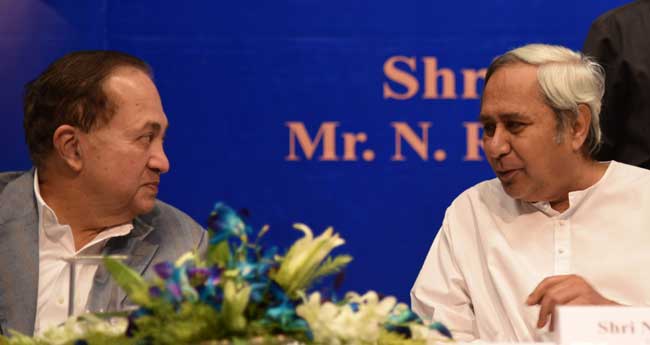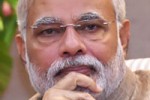Odisha Channel Bureau
Bhubaneswar: While raging debate on climate of intolerance is getting shriller by days with intellectuals from diverse fields expressing their concerns, media seem to be playing soft on the issue and acting like referee. Former Editor-in-Chief of The Hindu and veteran journalist N.Ram, who is very critical on media’s reaction, says news media and journalists en masse have not done justice to the gravity of the situation and have not risen full-throatedly to the challenge, in the way writers, film-makers, academic historians, and scientists have.
Apart from intolerance debate, he spoke about status and challenges of Indian media at great detail. Here is excerpt of Mr.Ram’s Pradyumna Kishore Bal Memorial Lecture 2015 delivered in Bhubaneswar on Sunday evening.

The following is the copy of N.Ram’s lecture: Pradyumna Kishore Bal Memorial Lecture 2015 Where are India’s news media going?
Differences of opinion are being sought to be settled by using physical violence. Arguments are met not with counter arguments but with bullets.When a poor man is suspected to have kept a food item that certain sections do not approve of, his fate is nothing short of death by lynching. At the launch of a book whose author happens to be from a country disapproved of by certain groups, the organiser is disfigured with ink thrown on his face.And when it is hoped that the Head of Government will make a statement about improving the prevailing conditions, he chooses to speak only about general poverty; and it takes the Head of the State to make the required reassuring statement, not once but twice.
When writer after writer is returning their award of recognition in protest, no comment is made about the conditions that caused the protest; instead the ministers call it a paper revolution and advise the writers to stop writing. This is as good as saying that intellectuals will be silenced if they protest.
Statement by 53 academic historians, October 2015
The crescendo of voices against the assaults on free speech, reason, and the scientific temper are gathering mass, getting louder, and being heard from all over India. Writers, film-makers, academic historians, scientists and other intellectuals are speaking up, protesting spiritedly in various ways, as we have not witnessed for a long time.And there is not a shred of doubt in anyone’s mind about who the assailants are.
The Sangh Parivar’s fingerprints are there behind virtually every assault during the period the Narendra Modi government has been in office. Arun Shourie, no less, has confirmed this and, what is more, he has certified the protests as righteous, just, and ‘Gandhian’. But the problem goes beyond the speeches and acts of the Sangh Parivar. There are also structural factors, embedded in the constitutional-legal system, that play on the side of the intolerants. Once a climate of intolerance is created, and is bolstered by official silence, apathy, or apologetics bordering on collusion, it is open season on targets at various levels.
It is open season on anyone whose writings, speeches, ideas, opinions, views, actions, and creative work a group can claim to be ‘offensive’ to its sensibilities.Under such circumstances, the constitutional guarantee of “freedom of speech and expression” becomes a nullity.And how have the mainstream news media responded to rising and spreading intolerance? To be fair, they have given some space to the various statements of protest.Newspapers in various languages have written editorials, for the most part, cautious, against intolerance and in defence of free speech.
News television channels have fielded debates on the subject, with the anchors usually playing neutral umpire, adopting the posture that much can be said on both sides. But have India’s news media and journalists done justice to the gravity of the situation, risen to the challenge, as they did, for example, in 1988, against the Rajiv Gandhi government’s infamous Defamation Bill? You may have your own impressions here. But I would say the news media and journalists en masse have not done justice to the gravity of the situation and have not risen full-throatedly to the challenge, in the way writers, film-makers, academic historians, and scientists have.
If this general observation is correct, the key questions that arise are: have the news media compromised themselves in some measure and, if yes, what are the trends and processes that have brought this about?Let me try to address these questions today, in memory of Pradyumna Kishore Bal, politician, journalist and media entrepreneur, educationist, rationalist, and humanist, a man who lived by his principles.We know he championed free speech all his adult life and fought against the Emergency in his own way.I was given access to Shri Pradyumna Bal’s hand-written letter of instructions, the “Book of Last Wishes,” dated August 30, 1996, that he left his family.It is a remarkable testament – poignant, principled, thoroughly rational, and brave – and it gives people like me who did not know him personally a real insight into the man and his worldview.I am happy that Pragativadi, the Oriya newspaper he founded as a weekly in 1973, is flourishing as a serious and respected daily.I thank his sons, Sambit and Samahit, and other members of the family for inviting me here and for giving me the opportunity to present my reflections and concerns about where the Indian news media are headed.Before I address the questions of current trends in the news media, their performance, and where they are headed, let me flag some conceptual issues and challenges, after disclosing that I have addressed them in papers and essays I have published and lectures I have given in different places.I draw on some of that material here.Concept and status of media freedom in India Let me first take up the concept and status of press or media freedom in our country.I assume that no one in this audience has any problem with the proposition that a democratic Constitution and the rule of law must give high priority to the protection of fundamental rights – and freedom of speech and expression is one of the most important among them.We used to think that when it came to press freedom, we were in an enviable position in comparison with most developing countries.But now, the picture appears far less bright on account of two factors – laws that are unreasonably interpreted and often misused to have a chilling effect on free speech, and the visible increase of intolerance in society and the polity, accompanying the rise of majority communalism and chauvinism and extremist tendencies among minority sections as well.Article 19(1)(a) of the Constitution of India guarantees “freedom of speech and expression” as a fundamental right.This right, hard won in the freedom struggle against a highly repressive and censorious British Raj, is deemed to be unamendable thanks to the ‘basic structure’ doctrine propounded by the SupremeCourt.Freedom of the press is not explicitly mentioned by the Constitution but the Supreme Court of India has, through judicial interpretation, read it into Article 19.It has held that freedom of the press is a combination of two freedoms – Article 19(1)(a), ‘the freedom of speech and expression’, and Article 19(1)(g), ‘the freedom to practice any profession, or to carry on any occupation, trade or business’.The first is clearly the principal component.Unfortunately, freedom of speech and expression is hemmed in, and to a significant extent undone, by Article 19(2).This provides for restrictions on the fundamental right prescribed by law – some reasonable, most not.Notable among the unreasonable restrictions that remain on the statute book or in practice are the law of criminal defamation, the undefined power of contempt of court, uncodified legislative privilege, the law of sedition (124A of the Indian Penal Code), other illiberal provisions of the IPC (especially 153A), the Unlawful Activities (Prevention) Act, and other draconian laws enacted in the name of fighting extremism and terrorism.And let us note that India is yet to follow Sri Lanka’s progressive example in being the first and only country in the South Asian region to do away with the law of criminal defamation, which it did as early as June 2002.Further, media freedom in India is considered ‘incomplete’ because the print media and the broadcast media have not been placed on an equal constitutional and legal footing.The higher courts have not judged it necessary to confer effective Article 19(1)(a) protection on radio and television.Social responsibility of the news mediaWhile calling attention to the urgent need to strengthen, protect, and entrench media freedom in India, we need to consider another issue side by side.Conventional wisdom in the west, and especially the United States, used to posit a laissez faire conception of a libertarian press with unbridled rights that no government and no external agency could be allowed to touch.The social responsibility conception arose in reaction to an extreme and self-serving form of this ‘we are not answerable to anyone but ourselves’ posture assumed by American press barons.In the U.S., the first systematic theory of a socially responsible press was presented in 1947 in the report of the Commission on Freedom of the Press, headed by Robert M.Hutchins.The Hutchins Commission laid down five ‘standards of performance’ for a free and responsible press.These were (1) to provide a “truthful, comprehensive account of the day’s events in a context which gives them meaning”; (2) to serve as a “forum for the exchange of comment and criticism”; (3) to offer “a representative picture of the constituent groups of society”; (4) to present and clarify the “goals and values of society”; and (5) to provide “full access to the day’s intelligence.”The specification of “standards of performance” needs revision and updating.But there can be little doubt that over the long term the conception of socially responsible news media has been influential and has come to stay.A substantial international literature has developed on templates for socially and ethically accountable journalism and also on the constitutive ‘elements of journalism’.This has yielded codes of practice or professional ethics that have privileged such principles as truth telling, freedom and independence, fairness and justice, humaneness, and working for the social or public good.The codes have emphasized such disciplines as fact checking, verification, investigation, rigorous data sourcing and analysis, providing context and meaning, and maintaining perspective.New approaches, such as ‘open journalism’ and ‘crowd sourcing’, new multimedia forms, and new disciplines, notably ‘data journalism,’ are beginning to change the face of journalism in this digital age.A necessary and important distinctionIn critically assessing media performance, a clear distinction needs to be drawn and maintained between the state or fortunes of the news media and the state of journalism.The point seems obvious enough but the two states tend to get conflated in public as well media marketing discourse.High growth rates in the media sector may offer opportunities but they do not guarantee quality.Let me now offer some very brief observations on the Indian media growth story.I won’t bother you too much with the statistics; they are readily available elsewhere.What they reveal is that “India is one of the few places on earth where newspapers still thrive,” as Ken Auletta puts it in a 2012 article in The New Yorker, and plenty of professional opportunities are available for journalists, especially young journalists.The Indian press, especially Indian-language newspapers, and satellite news television continue to be in growth mode.Some of that story has been splendidly researched, analyzed, and told by the political scientist Robin Jeffrey in his book, India’s Newspaper Revolution, published a decade-and-a-half ago and in a series of articles in the Economic & Political Weekly (1987, 1993, 1997).The key factors behind India’s newspaper revolution, Jeffrey points out, are improved technology, steadily expanding literacy, better purchasing power, aggressive publishing, and, last but not least, political excitement.There is a huge appetite out there for news and what masquerades as news, for analysis, for comment, and of course for entertainment and also for that hybrid creature, ‘infotainment’.All this has spawned tens of influential Indian language daily newspapers, many of them with large circulations and huge readership.The audience for television in India is huge, in the region of 620 million (according to IRS 2014) and still growing.However, this mass audience is largely for the entertainment channels.The dozens of 24 x 7 satellite television news channels that compete with the print media in English and the various Indian languages are estimated to account for only about 10 per cent of the total TV market.There are also signs that the long-expected shakeout is beginning to happen in the news television sector.But the buoyancy of the Indian news media must not be romanticised.For newspapers, the huge circulation numbers ride on the back of extreme underpricing of cover prices and the printing and dumping of hundreds of thousands of copies that go straight to the raddhi or used paper market for recycling.The latter, a sharp practice to inflate circulation for advertising gain, has become systemic.As though this were not enough, the Television Audience Measurement (TAM) system has come under widespread criticism and even frontal legal attack.What is now clear is that the economics of both the print and broadcast sector has been hardening, gradually.The advertising market has tightened in the last few years.The catalyst seems to be the global economic slowdown: it has taken its toll of the Indian media growth story, leading some industry experts to rule out any return to the pre-crisis situation, especially in the crucial matter of advertising revenues.A conceptual framework for evaluating media performanceI would now like to turn our focus on some relevance and quality issues.To do this, we need a conceptual framework to evaluate news media functions in society.The long-term Indian press experience, set in a broader framework, suggests two extremely valuable central functions or roles that the region’s best newspapers have played in modern and contemporary times.These functions may be termed (a) the credible-informational and (b) the critical-investigative-adversarial.An accompanying condition – which evolves over time, typically as an outcome of a democratic or working people’s struggle – is that the political system gives newspapers free or relatively free rein, and a public culture of valuing these functions develops.Performed over time, the two central functions working together build trust in the press, or more accurately, in individual newspapers.There are also valuable derivatives of the two central, twinned functions.The first derivative is the agency of the press in public education.A second is serving as a critical forum for analysis, disputation, and comment, in which different opinions and ideas are discussed, debated, and have it out.An idealized conception of this is attributed to the American playwright Arthur Miller: “A good newspaper, I suppose, is a nation talking to itself.’’ A third derivative is agenda building.Socially conscious media can trigger agenda-building processes to help produce democratic and progressive outcomes; and this they can do best when an authentic public opinion and a congenial context of attitude, feeling, and critical democratic values and practice exist.A third function of the news media is the pastime or entertainment function.At its worst, it seeks to purvey escapist entertainment, celebrity worship, vapid talk shows, scandal, and even voyeurism at the expense of everything else.But it can be something quite different – engaging, entertaining, delving into life’s small pleasures, covering hobbies and recreation, pandering to crossword and Sudoku addicts, mixing in humour and satire, lightening solemn, heavy, ponderous journalism, and in general serving the ‘pleasure principle’ as the French use that term.Evaluating media performance: the good and the badI have long believed that India’s news media derive their core strengths from modern history, especially where that history has been uninterrupted, more or less.Our press is more than two centuries old.It has always been a highly political press.Its strengths have been shaped by its historical experience and, in particular, by its association with the freedom struggle as well as movements for social emancipation, reform, and amelioration.The long struggle for independence; the sharp ideological and political divides; controversies and battles over social reform; radical and revolutionary aspirations and movements; compromising as well as fighting tendencies; and the competition between self-serving and public service visions of journalism – these have all found reflection in the character and performance of the Indian press, published in a remarkable plurality of languages, over the long term.It is this rich history that accounts for the seriousness, the relevance, and the public-spirited orientation of the press at its best.The tradition of a strong and assertive political press has continued and flourished.Investigative journalism is extensively practised, with investigations and exposés of political corruption making quite a splash in the polity.Today satellite television competes with newspapers aggressively in trying to influence the political agenda of the States and the nation.With their expanded reach, these news media together serve as an effective antidote to any trends of de-politicization in society.Further, there is still significant space for the expression of political dissent and contrary political opinions.Pluralism in the Indian media can be said to reflect the vast regional, linguistic, socio-economic, and cultural heterogeneity of the subcontinent.A positive factor for both the print media and news television is that over the past quarter-century, their social representativeness has broadened.For one thing, there has been a rapid feminization of the newsroom.Alongside this, the composition of the journalistic workforce has become more inclusive in socio-economic and regional terms.However, the number of Dalit journalists in the mainstream news media continues to be insignificant.Some of the finest work done by the Indian press, historically and in contemporary times, is its investigation and expose of political corruption, ministerial misconduct, and government misdeeds.In fact, corruption, in its myriad forms and tremendous scale, presents limitless opportunities to India’s independent news media to investigate, build on investigations done by official watchdog bodies, and do agenda building on the theme of corruption.This also enables them continuously to win strong public support for the work they do.The Bofors howitzer deal scandal and the sustained investigation and expose by the press, in particular The Hindu, captured the imagination of political India in the late-1980s, so much so that Bofors became a synonym for sleaze and skullduggery in various Indian languages.In recent years, the press and news television have aggressively probed, and agitated on, a series of corruption scandals that have shaken political India and eroded the credibility of the Manmohan Singh government.These include the 2-G spectrum scam; the scandal around the 2010 Commonwealth Games; the Adarsh Housing Society scam; the mining scandal, spread across several States; and the coal block allocation scandal, or ‘Coalgate’ as it was christened by the media.In all these recent cases, the irregularities and suspicious transactions were exposed by constitutionally or statutorily created authorities.But the role of the news media has been crucial in keeping up the heat, contributing new information or angles, and following up – thus helping to build a democratic public agenda on the theme of political corruption.The publication in early 2011 of a series of articles based on the U.S.Embassy cables on India, made available by WikiLeaks, provided the reading public and historians of contemporary India a wealth of information on foreign and domestic policy issues, and on corruption, the cover-up of corruption, and ministerial and official misconduct.One cable supplied explosive information on the 2008 ‘cash-for-votes’ scandal, where parliamentary votes were sought to be bought to help the Manmohan Singh government squeak through a no-confidence motion in the Lok Sabha.Hearteningly, publication of the story in the press triggered the launch of a criminal investigation under the watch of the Supreme Court of India.However, critics have noted, correctly, that the energy and motivation the Indian news media have shown in going after government and political corruption have been missing in investigating and exposing corporate corruption.The reasons for this I will go into a little later.I have given you an idea of the democratic role played by influential sections of the Indian news media in the sphere of politics.Unfortunately, when it comes to economic issues and policies, the mainstream media’s contribution turns out to be anything but democratic.This was not always the case.Amartya Sen has commended the historical role of Indian newspapers in exposing hunger-related facts on the ground in extreme cases and, in concert with other democratic institutions, preventing the government from pursuing disastrous policies and thus guaranteeing “the avoidance of acute starvation and famine.”Today a number of factors operating in the Indian media industry have virtually shut out news, analysis, and comment that challenge the neo-liberal economic policies that have held sway over the last two decades.Mainstream press and broadcast media coverage has tended to adopt a laudatory tone, keep out or underplay the criticisms and objections, censor the negative socio-economic effects, especially among the poor, and provide little space to the voices of robust criticism and opposition, including those raised from the ranks of professional economists.Critics point out that Indian journalism is facing increasing pressure from proprietors, advertisers, marketing personnel, corporate managers, and even senior journalists to present and prioritize ‘feel good’ factors – rather than highlight the reality of mass deprivations and what to do about them.In several frank conversations with the executives of India’s largest newspaper publishing company, Ken Auletta, a New Yorker specialist writer who explored the Indian newspaper scene and published an interesting piece titled “Citizens Jain” in 2012, learnt why poverty, especially rural poverty, was not a fit subject for news and editorial coverage, why this coverage had to cater to the ‘aspirational’ among young readers (because poverty was “not a condition to which one aspires”), and why a newspaper’s editorial philosophy, which was derived from its business philosophy, had to be one of optimism.But the problem, which is by no means confined to one or a few news organizations, goes way beyond this.The economist Prabhat Patnaik has addressed the subject in an original and unusually perceptive meditation on ‘Markets, Morals and the Media’.It was given as a Convocation address at the Asian College of Journalism, Chennai in 2002.There is no time now to go into the details of his argument.It is the conclusion I wish to draw your attention to here.We can call it Patnaik’s Law on media power in relation to economic issues: “where the media are on the same side as international finance capital, they appear powerful; but in fields where they strike out on their own, upholding humane values and expressing concern for the poor and the suffering, they appear powerless’.Such powerlessness, he proposes, is the outcome of a process, ‘the process of ascendancy of international financial capital over the economy, which the media, paradoxically, with a few honourable exceptions, have avidly supported.”Poverty and mass deprivation, basic livelihood issues, the impact of policies on these issues, the state of agriculture and the countryside remain massively under-covered in Indian newspapers and the broadcast media.The good thing is that the honourable exceptions Patnaik mentions have been significant.P.Sainath’s investigations of rural distress, farmers’ suicides, and mass migrations are in the finest traditions of people-oriented, investigative, agenda-building journalism.Such influential and iconic work, along with the lively contributions of young idealistic reporters on these subjects in various Indian languages, suggest a way out of this bind – provided a public culture of valuing such journalism can be built up.In the last few decades, we have seen a sharp acceleration of the negative trends: the manipulation of news, analysis, and comment to suit the owners’ financial or political interests; the downgrading and devaluing of editorial functions and content in some leading newspaper and news television organizations; systematic dumbing down, led by the nose by certain types of market research; the growing willingness within newspapers and news channels to tailor the editorial product to subserve advertising and marketing goals set by owners and senior management personnel; hyper-commercialization; price wars and aggressive practices in the home bases of other newspapers to overwhelm and kill competition; advertorials where the paid-for aspect of the news-like content is not properly disclosed or disclosed at all; private treaties; rogue practices like paid election campaign news and bribe-taking for favourable coverage.These trends are likely to get strengthened when the news media become subsidiaries, branches, and agencies of mega-corporations whose core business interests lie elsewhere.If this is what it takes to have thriving newspapers and other news media, then there is something seriously wrong with this growth path.The business of journalismKen Auletta’s New Yorker piece, Citizens Jain, offers an entertaining glimpse of an exotic world of aggressive and unorthodox publishing and business strategizing for growing newspapers that throws out of the window most of the things we have learnt from journalism school or The Elements of Journalism.The issue of ‘paid news’ exploded in the public sphere in the aftermath of India’s 2009 general election.A section of the press revealed that a large number of newspapers, small, medium-sized, and big, and also several television channels had sold promotional news packages of specified size, using an under-the-table rate card, to candidates in State Assembly and parliamentary elections.Candidates who could not pay, or refused to pay, were blotted out of news coverage.There were special rates for negative coverage of the candidates’ opponents.This involved violations of the law, was tantamount to extortion in several cases, and mocked every rule of ethical journalism.It was every bit of a rogue practice as the U.K.’s phone hacking affair was.The scandal of paid news led to a damning report by a sub-committee of the Press Council of India and calls for external regulation of the press and the private television channels.It also led to some critical debate on a wider phenomenon – paid news not as a rogue practice but as a deeper and industry-wide phenomenon that was not confined to election coverage.The journalist P.Sainath offers this handy definition: “Paid news is run to pass off an advertisement, a piece of propaganda and advertisement…as news…Paid news does not disclose to the reader that this information has been paid for.”To return to the theme of hyper-commercialization and what it means for journalism.Auletta’s top media interlocutors had no inhibitions in telling him that “we are not in the newspaper business, we are in the advertising business…a derived business…of aggregating a quality audience’’ for advertisers to “facilitate consumption.” He learnt about focus-group-led research that put “elitist’’ editors, “pompous fellows thundering from the pulpit, speaking in eighty-word sentences,’’ in their place.This was research directed by the marketing people into what readers, and especially “aspirational’’ young readers, wanted to read and the consequent restructuring and re-invention of editorial content.Auletta was educated in easy rationalizations of the practice of ‘advertorials’ – an ad-sales initiative that opened a section of the newspaper to promotional or puff pieces paid for by celebrities, brands, and well-heeled ego-tripsters, and written not by ad agencies but by the newspaper’s reporters.There was some kind of indication that this section was paid for but a reader needed “a magnifying glass to be alerted’’ to the disclosure in small print.The New Yorker writer also learnt about another business innovation originating from India’s largest newspaper-publishing company but now fairly common in the media industry – ‘private treaties,’ a programme under which newspapers offer ads to smaller and medium-size companies in exchange for equity.The conflict-of interest implications of this initiative for editorial coverage of these companies by the newspapers have been much discussed among journalists and critics of the Indian media industry.They even attracted the attention of the Securities and Exchange Board of India (SEBI); in a 2009 letter to the Press Council chairman, SEBI warned that “private treaties may lead to commercialization of news reports since the same would be based on the subscription and advertising agreement entered into between the Media group and the company.Biased and imbalanced reporting may lead to inaccurate perceptions of the companies which are the beneficiaries of such private treaties.”The elephant in the room that is rarely discussedIt is axiomatic that the assertion and practice of media freedom and independence cannot be exclusively against regimentation, control, and heavy-handed regulation by the state and its instrumentalities.An internal structure that enables and empowers its journalists to practise freedom, independence, and social responsibility, sets high standards of intellectual and professional performance, and motivates them to achieve these standards is equally important.“Freedom of the press is guaranteed only to those who own one,” the American journalist A.J.Liebling wrote in his “The Wayward Press” column in The New Yorker 55 years ago.“What you have in a one-paper town,” he went on to observe, “is a privately owned public utility that is Constitutionally exempt from public regulation, which would be a violation of freedom of the press.As to the freedom of the individual journalist in such a town, it correspondents exactly with what the publisher will allow him.He can’t go over to the opposition, because there isn’t any.”A deeply worrying global trend, which is beginning to be observed in India too, is the buying out wholly or in large part of major media organizations by large business groups whose core businesses are unrelated to the news media.The aim in most cases is to use established media players single-mindedly to further their business interests.The motives could vary: it could be to ingratiate themselves with political parties or the government and position themselves and their core businesses favourably for the award of licences and territories; it could be to acquire oppositional political clout; or it could be for some other complex reason.Media take-overs, mergers, and the process of conglomeration have been happening in the developed world for a few decades now.The media world has long been accustomed to the ways of Murdochism and to the even bigger story of how five mega corporations – Time Warner, Disney, News Corporation, Bertelsmann, and Viacom – came to own most of the newspapers, magazines, books, radio and TV stations, and movie studios in the United States.But it was the $315 million acquisition in February 2011 of Huffington Post – an independent, idealistic and pioneering free-to-air online news and opinion site founded by Ariana Huffington – by multinational technology company AOL that made people sit up and wonder what was happening in the digital media space.AOL, in turn, was acquired by Verizon Communications, a broadband and telecom giant, four years later.Around the time of India’s 2014 general election, a major television group with a sizeable following, a hard-won professional reputation but fragile finances was taken over by India’s top business group, leading to the exit, before and after the election, of several journalists, including one of India’s best-known television personalities.The post-takeover scenario in this case is still unfolding.There has also been market buzz that some Indian newspapers that have been bleeding financially for years have landed themselves in a position of financial dependence on big business patrons to keep afloat.As the fragile finances of several established old media organizations come under increasing pressure from a combination of factors in this digital age, the prospects of take-over by big business groups with core businesses unrelated to the media will grow stronger.L’affaire BiharIt is difficult to measure the impact of these cumulative negative tendencies and the structural factors on the independence of the news media or the quality of their journalism.But the coverage of the just concluded Bihar Assembly elections by the major English language news television channels tells its own story.Historically, the Indian news media, newspapers as well as private television channels, have had a mixed record of success in forecasting elections.But never has the credibility of opinion polling and exit polling commissioned by the major news television channels taken such a body blow as it has done this time.Virtually all the supposedly scientific forecasts, even those that predicted a victory for the Nitish-Lalu-led Mahagathbandan, were way off when it came to the numbers.Curiously, the one exit poll, done by Axis APM, which we now know came up with the uncanny prediction that the Mahagathbandan would score 169-183 seats, the BJP-led alliance 58-70 seats, and Others 3-7 seats, was suppressed by the channel that had commissioned the poll, for reasons we can only guess at.But that was by no means all.Even when the counting was well under way, all but one major English language channel had the BJP and allies leading, one channel by 85 against 55 at 9.20am.A well-known anchor even tweeted at 9.25 am that her channel was calling the election and that “BJP and allies [were] all set set to form the government in Bihar with 145 to 149 seats.” And it turned out that the channel that had suppressed the uncanny forecast by the Axis APM exit poll was way ahead of the competing channels in reporting the lead position through the day and was also the first to call the election for the Mahagathbandan.Interestingly, while it has remained silent on why it failed to telecast the findings of the one exit poll that was spot on, at least so far as the division of seats was concerned, it has not let us forget for a moment that it was the most accurate in reporting the leads and the first to call the election.Making factual mistakes is quite common in journalism and professional ethics demands that once discovered, the process of correction should be quick, open, and transparent.There have been suggestions in the social media and in the political sphere that the coverage of the 2015 Bihar Assembly election by the major English language TV channels has been under extraneous pressure, you know from whom.I don’t think we should rush to judgment on such issues or paint everybody with the same brush.But the channels certainly owe their followers and the public a serious explanation going beyond an acknowledgement of garden variety factual errors.What is to be done?We can now abstract from the particular to indicate a future scenario for the Indian news media.It is likely that given the trends of hypercommercialization, commoditization, trivialization, and venality that are a growing part of the Indian news media scene, the pressure from politicians and the public to impose external regulation through legislation will increase.For the media organizations, demonstrating that transparency, accountability, and social responsibility are more than slogans will no doubt help.So will introducing codes of values and codes of good practice binding journalists and the media industry, and instituting self-regulation mechanisms such as independent news ombudsmen within major news organizations.But these necessary measures are likely to be no more than surface-level remedies unless we seriously address the structural issues relating to ownership, control, and manipulation of the news media by those who have no real interest in, or commitment to, free and independent journalism and its value framework.The real challenge is to find economically sustainable and politically astute ways and means to loosen and eventually to break the stranglehold big business has been establishing over the news media to the detriment of free and independent journalism in a seemingly irreversible historical process.Let me close by saying how pleased I am to be able to raise these critical issues before you, on an occasion that has real significance for the news media and society.















